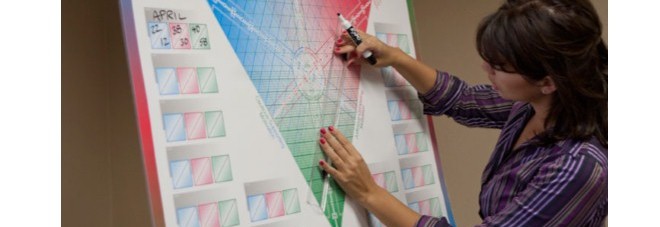As the CEO (Chief Energizing Officer) at Hartful Living including GaiaHart.com and BizBuilderCards.com; I’m a Messenger and Mentor for women entrepreneurs, connecting them to their capacity to energize their work and their lives in the art of living Hartfully. At BizBuilderCards.com, you can make a living through giving with greeting cards and gifts to build your network net worth as an additive to your current business or an easy way to send gratitude and kindness to the world.
Top Talent Traits of Successful Entrepreneurs

September 3, 2014 | Posted in Leading Hartfully, Living Hartfully, Wealthy Woman | By Gaia Hart
People I meet who are contemplating jumping into the deep waters of independent income earnings always wonder if they can do it, do they have what it takes, and should they even be thinking about it. A recent survey of Millennials, those born between 1980 and 2000, by Deloitte found that a full 70% of them think they will be working independently some day and jumping off the corporate band wagon.
I first offer guidance to those inquiring minds that they need to have their personal and financial act together first and foremost, have their dream and their passion and purpose pulled together, a bank account with at least one year’s worth of living expenses, no debt, and be able to live with ambiguity, flexibility, and creativity.
Successful entrepreneurs have qualities to cultivate deep relationships with customers and employees, have great focus on business outcomes, are creative problem solvers, and are the best spokespeople for their businesses. They don’t shy away from self-promotion and exert a self-confidence even if they don’t yet have it.
The top talent traits of successful entrepreneurs:
- Business Focus: You make decisions based on observed or anticipated effect on profit.
- Self Confidence and Confidence in Others: You accurately know yourself and understand others can do some things better than you and you let them do it.
- Creative Thinker: You exhibit creativity in taking an existing idea or product and turning it into something better.
- Determined Independence: You last through difficult times and are prepared to do whatever needs to be done · Knowledge-Seeker: You constantly search for information that is relevant to growing your business.
- Promoter and Relationship-Builder: You have high emotional intelligence and easily build relationships
- Risk-Taker: You instinctively know how to manage high-risk situations.
Take stock of your own talents and skills to see if you have these top talent traits that most successful entrepreneurs embrace. Understanding and acknowledging your inherent talents gives you the best chance at success. All the best in your success and if you need a little help along the way, you know where to find me.
Insert: Insert Energy Into Your Day

August 16, 2014 | Posted in Leading Hartfully, Living Hartfully | By Gaia Hart
Fill your day with energy inserts, short breaks, breathing room, downtime, toys, and playful items that speak to you and that are appropriate or allowed in your workplace. Studies show that using colored pens, stickers, and getting creative will cause you to look forward to your daily planning sessions. When we plan our time better, we usually have more time to insert some energy into our schedule.
Turn your planner into an adult version of a coloring book and color-code your schedule to quickly see how balanced or unbalanced your life is. With a quick glance at your colorful calendar you can see immediately which color dominates or if they are in balance. Our eyes see color before they see words, so using different colors for personal, professional, meetings, deadlines, or other categories will save you time and eyestrain from reading all your activities. Plotting both personal and professional time slots in your palm pilot or day timer will help you schedule your day and keep you from becoming overscheduled, over-committed, and overwhelmed.
Recognize that you will need some downtime for your brain or your body after a taxing project and schedule the downtime into the project planning time. Insert pleasurable things into your day to help you practice safe stress and mark it on your calendar. Some clients have a family calendar on the refrigerator and use a different color for each family member on the master calendar for easier planning.
Professionalism can be playful – remember fun and effectiveness? Energy inserts could be candles, flowers, juggling, music, people, pets, art, free time, fresh air, or anything else which makes your smile or nourished your soul. Create your Fun Meter list and write down as many things as you can that make you smile and that you enjoy doing in your leisure time to practice safe stress.
Taking several joy breaks daily can liven up your life. Look at photos, stretch, call a friend, turn on music, have fresh flowers, walk outside, or move your body to release the tension and get your left and right brain integrating more effectively. Research shows that those who plan for daily joys can cope with stress much better than those who don’t. Become aware of what brings you joy and create moments in your routine to experience aspects of that positive feeling. Just thinking about joyful things brings positive physiological and psychological changes in your body.
Joy is a step beyond happiness; it is more active and animated than plain happiness. What joyful things are you putting into your life as an energy insert today? See Appendix A for more energy inserts to get you started on your own list. If you have trouble wondering what to do with an extra 15 minutes in your day, keep your list handy and start inserting some energy and joy into your day.
What Energizes a Workplace and a Workforce, Anyway? The Softer Side of Leadership

July 29, 2014 | Posted in Leading Hartfully, Living Hartfully | By Gaia Hart
I began studying what energizes individuals about 30 years ago and it morphed into researching what energizes organizations in the 1990’s. It was fascinating to me how some people had so much energy to burn and others seemed drained much of the time. The same with organizations. Some seemed to have an engaged and excited workforce powered on their own “esteem engines” and others needed the command control to keep them producing out of fear and threat of paycheck revocation.
When I read about the enormous undertaking of one of Gallup’s largest and longest undertakings studying employee engagement; it proved what I had been seeing first-hand in consulting with companies around the world. A mere 30 % of employees in America feel actively engaged at work. And now their 21013 version of the study found that around the world it falls to just 13%. Their study goes on to report that 55% are disengaged and 20% are actively disengaged and doing things to sabotage the effort. So instead of work being an enthusiastic expression of our gifts and talents; it would seem that it is anything but for most employees.
Last fall, interested in what makes employees satisfied, energized and productive; the Harvard Business Review conducted a survey of more than 12,000 mostly white-collar employees across a broad range of companies and industries and results were remarkably similar across all populations.
Employees are vastly more satisfied and productive, when 4of their core needs are met:
- Physical, through opportunities to regularly renew and recharge at work
- Emotional, by feeling valued and appreciated for their contributions
- Mental, when they have the opportunity to focus in an absorbed way on their most important tasks and define when and where they get their work done
- Spiritual, by doing more of what they do best and enjoy most, and by feeling connected to a higher purpose at work
The more effectively leaders and organizations support employees in meeting these 4 core needs, the more likely they experience engagement, loyalty, job satisfaction and positive energy at work, and the lower their perceived levels of stress. When employees have one need met, compared with none, all of their performance variables improve. The more needs that are met, the more positive the impact.
Employee engagement that includes involvement, commitment, passion, enthusiasm, focused effort and energy has been found to improve performance. Something we know in our gut and something Gallup once again proved to be true. Gallup found that companies in the top quartile for engaged employees, compared with the bottom quartile, had 22 % higher profitability and 10% higher customer ratings. The way we feel at work is critical to how we perform.
The following is an excerpt from a report of that study:
Renewal: Employees who take a break every 90 minutes report a 30 percent higher level of focus than those who take 0-1 during the day. They also report a nearly 50 percent greater capacity to think creatively and a 46% higher level of health and well-being. The more hours people work beyond 40 — and the more continuously they work — the worse they feel, and the less engaged they become. By contrast, feeling encouraged by one’s supervisor to take breaks increases by nearly 100 % people’s likelihood to stay with any given company, and also doubles their sense of health and well-being.
Value: Feeling cared for by one’s supervisor has a more significant impact on people’s sense of trust and safety than any other behavior by a leader. Employees who say they have more supportive supervisors are 1.3 times as likely to stay with the organization and are 67% more engaged.
Focus: Only 20% of respondents said they were able to focus on one task at a time at work, but those who could were 50% more engaged. Similarly, only one-third of respondents said they were able to effectively prioritize their tasks, but those who did were 1.6 times better able to focus on one thing at a time.
Purpose: Employees who derive meaning and significance from their work were more than three times as likely to stay with their organizations — the highest single impact of any variable in our survey. These employees also reported 1.7 times higher job satisfaction and they were 1.4 times more engaged at work.
Leaders must embrace the softer side of business and know that how employees feel is as important as what they know and what they can do. If they don’t feel like doing it, they won’t. If they don’t feel valued, they walk. If they don’t feel respected, they leave or call in sick. If they don’t feel inspired and energized and feel like they matter; they won’t produce. Leaders much pay attention to what was previously thought of as soft skills and ensure they ask employees what would make them feel more energized, more cared for and what would improve their quality of life at work.
Other things I’ve seen client companies do is to create fitness facilities and nap rooms, and to provide healthy, high-quality food for free, or at subsidized prices, offer dry cleaning pick-up or car detailing in the workplace. Others offer Fed-ex and UPS delivery and drop off for employees and promise not to make meetings more than 90 minutes tops. Still others have bowls of M&M’s next to the coffee pots in the break rooms. What can you do as a leader to embrace the softer side of the workplace and energize your employees? It starts with a simple question of asking them what they want out of the relationship with their job and what do they need to feel better about working there. Baked goods is always a good start.
The energy of leaders is contagious. When leaders explicitly encourage employees to work in more sustainable ways and model that behavior; their employees are substantially more engaged, more focused, and more likely to stay at the company, according to the Harvard Business Review. Start inquiring now before you lose more employees to someplace that cares more about them, shows them they are concerned with how they feel and shows how they value them on many levels.
CTRL – Control Your Life and Your Immediate Environment

July 12, 2014 | Posted in Leading Hartfully, Living Hartfully | By Gaia Hart
Take control of your immediate circle of influence. You don’t always have control over what comes your way, but you have the power to control your state of mind and reactions to whatever life hands you. When you change your mind, you change your energy, and when you change your energy, you change your life. Our thoughts turn into actions and our actions turn into habits and our habits turn into our character . . . so what are you thinking about?
You can also control your immediate physical environment. Give yourself an energy boost by hanging up cherished photos, or have a nice rug under your feet, play soft instrumental music to soothe your nerves, and have your space make a positive statement about who you are. What image do you want to portray with your space. Is it working for you or against you? Take control of your immediate environment whether it be your space, your thoughts, or your circle of friends. Our clutter is a symptom of our internal chaos – a visual of postponed decisions and procrastination. Is your environment telling others you have control or that you’re out of control? Take control over what you have the power over and let go of things that are out of your control to avoid undue energy drainage.
On Being Happy, How to Happify Your Life

July 1, 2014 | Posted in Leading Hartfully, Living Hartfully | By Gaia Hart
It’s a funny thing this happiness trend. Like when you buy a new car and then you keep noticing all the cars on the road like yours because it’s on your radar. I keep having these happiness studies, books, websites and articles drop into my lap while I wait at the car wash, doctor’s office, watching TV or on a teleclass where a book is referenced by my coach. I’m getting bombarded with happiness messages and just have to share the good news.
The latest one is a website called http://www.happify.com all about the science of happiness and how you can live a happier life be design. This website is no slouch, it was featured in Forbes, Fast Company, Redbook and Shape magazines and it has years of scientifically-based research behind it. Finally corporations are getting it that happy workers make for better business. When work is made fun, it gets done and good times lead to good business. Us folk in the recreation field have known that all along. I’m glad the corporate suits are getting clued in to how the bottom line is affected by how happy employees are in the workplace and at home. I write about it many years ago in How to Create a Happy Herd: the Contented Cow Syndrome as one of the cover stories in one of Stephen Covey’s magazines. I’m thinking of dusting it off and re-printing it for your reading pleasure.
Anywho…. back to the Happify website. They claim that spending a few minutes daily on fun, science-based activities and games can improve your life on many levels including: gaining confidence, boosting optimism, decreasing stress, building resilience to stress, improve relationships and conquer negative thoughts. Everybody seems to be getting on the gamifying bandwagon these days….like the website Lumosity – to train your brain to be smarter. Why not give it whirl and see how you can happify your life. There are lots and lots of articles for lots of areas of your life that can be happified. Happy reading….
Home: How is Your Home Life?

June 24, 2014 | Posted in Living Hartfully | By Gaia Hart
Is your home a sanctuary of safety and security or is it a part-time job? Is your home a place to unwind or it is a place that winds you up tight? Take a look at the emotional and physical environment that surrounds you and opt for low-maintenance alternatives. How are your relationships and your leisure lifestyle? What we do in our free time speaks volumes more about us than our job title.
Are you creating an authentic lifestyle the way YOU want to live, and not following somebody else’s guidelines? Are your relationships energizing or emotionally draining? Is your home life congruent with your work life? Does your home life recharge you or exhaust you? Does your home accurately represent who you are today or are you living amongst hand-me-downs or yesteryear’s things? Does your home really reflect your spirit and who you want to be?
Look at your leisure-time patterns and adjust them to improve your energy. Our home life needs to be refreshing, rejuvenating, and nurturing for us to recharge for the workweek or whatever the world throws at us. Do an inventory at home and figure out what is holding you hostage. Take action to create a welcome and hospitable home to envelope you in peace, comfort, and joy.
How Do You Do Conflict? Are You in Conflict over Substance or Style?

June 9, 2014 | Posted in Leading Hartfully, Living Hartfully | By Gaia Hart
I recently read in another Leadership blog citing a study of top leaders that found they spend up to 26% of their day doing conflict management. With that kind of time related to solving conflicts at work, it behooves us to learn more about conflict management and conflict sequences and how to resolve issues effectively. Relationship Awareness® is founded on the guiding principle that we are each seen as the expert on ourselves – only we know our true, authentic motives for behaving and communicating as we do. And once we discover our motives and learn about ourselves, then we have the responsibility to use that knowledge to the best of our ability for positive effort and/or change in the world in relating to others. Relationship Awareness is also built upon four simple yet profound premises:
- We all do what we do because we want to feel good about ourselves and protect our self-worth.
- We tend to take two different approaches to life:
- When things are going well, in our everyday life
- ‘When we are in conflict or are challenged and stressed about something
- A “personal weakness” is no more or no less than the overdoing or misapplying of a personal strength and one that others do not value. We can misapply our strengths in four different ways:
Frequency – we deploy it too often or not enough
Duration – we deploy it for too long or not long enough
Intensity – we deploy it with too much power or verve, or with not enough zest or passion
Context – we deploy it in the wrong place, with the wrong person or at the wrong time or any combination of the three
- We naturally tend to perceive the behaviors of others through our own filter, our Motivational Value System, one that we have grown up with and reinforced by our behavior throughout our lives.
The Strength Deployment Inventory (SDI)® is a whole-life, dual-state, interpersonal inventory focusing on motivation when things are going well and changes in motivation in conflict situations or when we are faced with a problem or challenge to our self-worth. Some of us change our behavior dramatically when we are in conflict and we don’t seem to exhibit the same types of clustered characteristics normally associated with our Motivational Value System that we “own” when things are going well. Others exhibit very little behavior change when they are faced with opposition or conflict and their outward behavior seems to reflect the same types of characteristics that they exhibit when things are going well.
Relationship Awareness Theory addresses these differences of motivation by identifying the three stages of conflict as well as the Conflict Management Sequence that each of us goes through when faced with a challenge to our Motivational Value System. Behavior in conflict can best be understood and managed when the purpose behind it is clear. The costs of conflict are well-documented – high turnover, grievances and lawsuits, absenteeism, divorce, dysfunctional families, prejudice or fear.
There are two types of conflict: warranted conflict and unwarranted conflict:
- Warranted Conflict – when each party wants different outcomes or desired goal (I want to go out for dinner and you want to stay home and skip dinner)
- Unwarranted Conflict – when each party wants a similar outcome, but the means or style of getting there differs (we both want to go out to dinner and I want fine dining and you want fast food)
A conflict sequence is a predictably sequential set of changes in behavior and communication styles and focus during conflict. There are three stages of conflict and our focus and communication style changes in each deepening stage. We move through the three stages when we cannot resolve the conflict in the previous stage. Each of us moved through these sequences at different rates and with a differing set of characteristics as mentioned above. Knowing another person’s conflict sequence can help you determine which stage of conflict they are in at the moment and can help you predict where they are going next, or on what they are focused. It can help save face, feelings, misunderstandings, time, effort, energy, and money or other resources. The three stages of conflict have these characteristics:
- Stage One – the focus is on me, you and the problem, and on maintaining self-worth: we speak professionally, civilly and work together to attain desired outcomes while looking at the problem and considering each other’s feelings. I may accommodate others, rise to the challenge or be prudently cautious.
- Stage Two – the focus is on me and the problem, and on preserving self-worth: you drop out of the equation and I may surrender conditionally, fight to win or pull back and analyze the situation.
- Stage Three – the focus is on me and protecting my self-worth: I may not even remember what we are fighting about or care to be respectful of you; I just want to win and save face in the process. I may surrender completely, fight for survival, or withdraw completely.
Our ability to focus diminishes in each progressive stage of conflict; we are more likely to attempt to resolve conflict at Stage One – where the parties involved are still concerned about each other. We see more clearly the costs of allowing conflict in the organization to get stuck at Stage Two – where a lack of concern for the other party generates turf battles and stifles communication. By coming to understand our own conflict sequences better, we feel more empowered to manage the conflict in our lives. Some organizations who have employed the use of the SDI in their conflict management pursuits have realized a 6841% return on investment by avoiding formal and informal grievances, saving them hundreds of thousands of dollars in direct and indirect costs.
Relationship Awareness tools help us to identify the source of our conflict and manage it more effectively – reducing unwarranted conflict and turning warranted conflict into opportunities for growth and the strengthening of relationships. These tools are unique among conflict management tools because they assess our motivational values. They get at the reasons behind conflict behaviors and show how those reasons connect to our motivational values when things are going-well.
We learn to recognize these changes in ourselves and in others – then learn what to do about it. Once we have a better understanding of ourselves and how we operate, communicate and move through the world, our self-mastery helps us become aware of how others move through their world. This ever-widening sphere of understanding helps individuals, organizations, families, teams and others communicate on a more authentic level for more successful outcomes. Relationship Awareness® is a registered trademark of Personal Strengths Publishing. For your very own personal assessment and facilitated consult to see where you stand in the conflict management spectrum, contact Gaia@GaiaHart.com.
More on Happiness and Your Health

June 1, 2014 | Posted in Leading Hartfully, Living Hartfully | By Gaia Hart
It begins with happiness. Happiness is not the end state. Happiness is the starting point that leads to all kinds of positive things in your life including your health. Choosing to insert moments of happiness into your day (I call them holi-moments instead of holidays), is like a string of pearls of joy. Stringing together all the pearls of happiness each day creates a happy, healthier life. Here are some of the things stemming from happiness as a secret ingredient. Extensive research in the Positive Psychology movement of the past couple decades has proven that happy people:
- Have fewer strokes and heart attacks
- Get sick less often in general – fewer colds, viruses and flu incidents
- Have a stronger immune system in general
- Have less pain and inflammation
- Sleep better
- Develop resistance to stress and adversity
- Enjoy improved work performance and success
- Have more fulfilling and longer-lasting marriages
- Attract more friends and are more social
- Are more altruistic and have a greater positive impact on society
- Attract more wealth
- Are more connected and active in their communities
- Have a larger network
- Live longer
The research is very clear that these things don’t lead to happiness. The exact opposite is true – that happiness leads to these positive outcomes. Happiness is the first ingredient to living a better life all the way around. We’ve had it backward for many years – thinking that IF we have these other things, THEN we’ll be happy. Now we have scientific evidence that the polar opposite is true – happiness comes first to attract these other things. Happiness is something we can do right now to start attracting these other things to us. Albert Schweitzer summed it up well: Success is not the key to happiness. Happiness is the key to success.”
